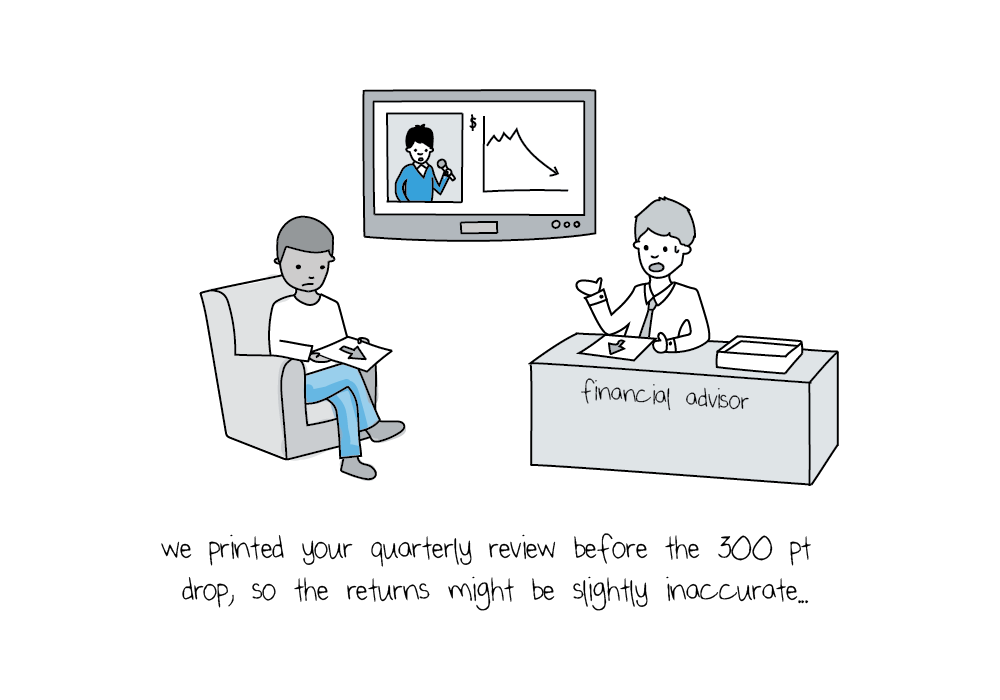In 2016, Wells Fargo’s Wealth and Investment Management Division earned $3.9 billion on $15.9 billion in revenue – a 24.5% pre-tax margin. JP Morgan Chase’s Asset & Wealth Division earned $3.5 billion on $12.0 billion in revenue – 29% margin. Bank of America Global Wealth, that boasts 18,688 wealth advisors, earned 23%. Shall I go on?
These three firms are just a tip of the industry iceberg. Insurance companies (think Northwestern, Prudential), advisory firms (think Fidelity, AG Edwards, Schwab), community and regional banks (think SunTrust, small local banks)—are all players in this cash cow business. And just think – these firms earned this much profit after their bloated expenses such as average salaries of $118,050[i], huge marketing budgets (not sure the PGA Tour would exist without them), rents in the most expensive skyscrapers, and high executive compensation.
Their Business Model is Deeply Flawed
While financial advisory firms get paid a few different ways, the main formula is charging clients an annual fee based on a percentage of investable assets. The percentages vary across assets classes, but if you have a cool million, 1% is a typical rate. For example, if you inherit $1 million and invest it with an advisor you’ll pay $10,000 (1%) each year. (You’ll actually pay more because the 10,000 doesn’t include backend fees other money managers charge you as well. But for simplicity sake, we’ll stick with 1%).
Here are the main services you’ll get in return for your $10,000 each year:
- Assessing your goals and risk appetite to create a financial plan appropriate for you.
- Managing your money by selecting investments.
- Safe-keeping your investments in a brokerage house.
- Meetings on a quarterly basis to discuss financial performance, adjust your investments, and answer your questions.
Safekeeping of assets is basically a free service so nix that. Rarely do money managers beat the S&P 500, and index funds are nearly free so nix that. Therefore, the main thing you’re getting for $10,000 is advice. Let’s compare financial advice to legal advice. Let’s say you hire a lawyer and pay him or her $3,000. You’ll notice this $3,000 because you have to write a check for the services and it’s a one-time event. You’re frustrated by the $3,000 despite the fact that lawyers provide a schedule of the time they’ve spent on your legal matter. But when we pay financial advisors $10,000 every year, we don’t notice because the amount is deducted from the annual return of these investments.
Is the $10,000 for advice a good deal? Let’s assume a typical financial advisor’s time is worth $100 an hour to you. The advisor would have to work on your account 100 hours per year to bill you $10,000, but I bet you a typical advisor spends 20 hours on your account, max. Most advisors have hundreds of clients and spend most of their days selling to get new accounts. No wonder the profits are so high for providing financial advice with this business model.
The other problem with this model is that advisors are paid the most when your money is invested in stocks. Therefore, their advice is rarely “independent” because if you sell your stocks to buy a house, that’s bad for them. The result: they often dream up reasonable reasons you shouldn’t sell your stocks. Also, they often get kickbacks from mutual fund companies. For example, if they invest your money with a particular mutual fund, they earn incentives.
Where There’s Brokenness, There’s Opportunity
Slowly but surely, this industry is being disrupted. The 2016 Wells Fargo fees decreased to $9.2 billion from $9.4 billion in 2015 predominantly due to lower transactional commission revenue. But leading up to 2016, most banks saw reasonably large increases in commissions.
Here are just a few examples of startups disrupting the old-fashioned advisory business model:
- Fee-Only Small Advisory Firms: For a set annual fee, small advisory firms provide unbiased advice and great service. One big difference between this model and the existing “percentage of assets” model is that fees are NOT calculated as a percentage of assets; therefore, there are not biases from the advisor and you clearly understand how much you’re paying. Clients are loving working with these firms because there’s full transparency in terms of how their advisors are paid.
- Technology Tools: Hundreds of financial tech startups are being created every day. For example, Divvy Investments built technology that helps individuals and advisors appropriately allocate their investments.
- Alternative Models: Wealthfront, Betterment, and several other “robo” advisory firms are springing up that offer alternatives to the traditional business models. These fast-growing startups offer phone support, easy-to-use features, and helpful advice – for a fraction of the fees.
These are just a few of the good ideas. There are heaps of billions to be harvested if you have the dedication and desire to make it happen.
[i] http://money.usnews.com/careers/best-jobs/financial-advisor/salary
Sign up to get more great insights directly to your inbox.
As a special bonus, you'll also immediately get access to my inside analysis of what made 172 diverse companies achieve take-off revenue growth.

